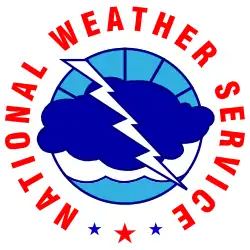National Weather Service Shreveport, Louisiana
National Weather Service - Shreveport, LA (SHV) is one of 122 weather forecast offices around the United States. It is responsible for issuing public and aviation forecasts and warning for South Central and Southwestern Arkansas, Southeastern Oklahoma, and Eastern and Northeastern Texas Counties, as well as for North Central and Northwestern Louisiana Parishes. It is co-located with a weather radar (KSHV) of the NEXRAD network and an upper air sounding facility. It controls the issuance of weather information and bulletins on a certain number of NOAA Weather Radio.
 | |
| Types | branch |
|---|---|
| Location | Shreveport |
| Country | United States |
| Coordinates | 32°27′04″N 93°50′30″W[1] |
| Website | www |
Mission
The mission of the Shreveport office is analyse meteorological data from weather stations, weather radar and satellite, and numerical weather predictions to issue forecast and warnings for forty-eight counties and parishes, centered around Shreveport, Louisiana. This includes 1 county in extreme Southeast Oklahoma, 9 counties in Southwest and Southern Arkansas, 21 counties in East Texas, and 17 parishes in Northwest and North Central Louisiana.[2]
These forecasts are for general public, aviation and fire weather control. The aviation forecasts, are issued every 6 hours for 7 airports in the Shreveport coverage zone, including Shreveport Regional Airport. Fire weather forecasts are produced for fire officials and firefighting efforts.[2] Watches, warnings, and advisories for severe thunderstorm and tornado watches are issued by the Storm Prediction Center (SPC), in Norman, OK, but are coordinated with the SHV office. All other watches and all warnings and advisories are issued by the local office in Shreveport.[2]
Tools
The current office is co-located and maintain a Doppler weather radar and an upper air sounding facility. The latter is launching weather balloons to measure the atmospheric temperature, winds and humidity up to 100 thousand feet above ground twice daily at 00 and 12 UTC. During high-impact events, such as impending severe weather, winter weather, or when a hurricane is approaching the United States, balloon launches may occur more frequent. Data from the balloon launches are plotted on Skew-T log-P diagrams.[2]
The meteorologists use the Advanced Weather Interactive Processing System (AWIPS) to monitor the weather situation and issue forecasts.
NOAA Weather Radio Stations
Forecasts, observations, watches, warnings, and advisories are transmitted through a number of NOAA All Hazards Radio transmitters 24 hours a day:[2]
| Callsign | Cities | Frequency | Region |
|---|---|---|---|
| WXJ65 | Broken Bow, OK. | 162.470 MHz | McCurtain County |
| WNG650 | Center, TX. | 162.525 MHz | Shelby County |
| KWN32 | Gilmer, TX. | 162.425 MHz | Upshur County |
| WXK23 | Lufkin, TX. | 162.550 MHz | Lufkin-Nagocdoches |
| WXJ96 | Monroe, LA. | 162.550 MHz | Monroe-Ruston |
| WNG725 | El Dorado, AR. | 162.525 MHz | El Dorado |
| WXN87 | Natchitoches, LA. | 162.500 MHz | Southeast Ark-La-Tex |
| WXJ97 | Shreveport, LA. | 162.400 MHz | Ark-La-Tex |
| WXJ49 | Texarkana, TX. | 162.550 MHz | Texarkana metropolitan area |
| WXK36 | Tyler, TX. | 162.475 MHz | East Texas |
| WNG653 | Marietta, TX. | 162.525 MHz | Atlanta-Linden |
References
- https://www.weather.gov/shv/.
- NWS Office in Shreveport. "About our Office". National Weather Service. Retrieved 2021-01-02.